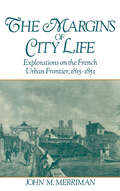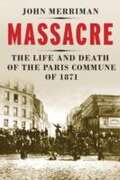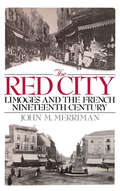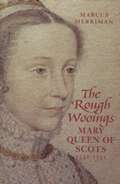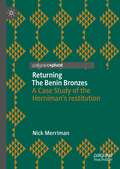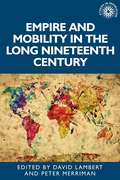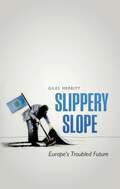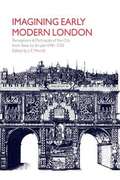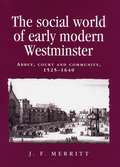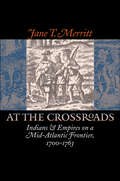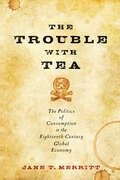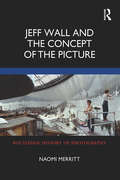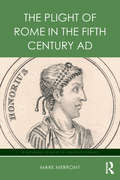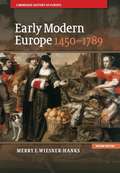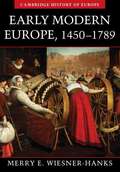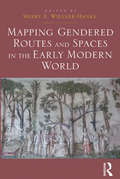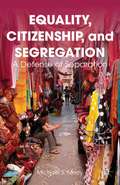- Table View
- List View
The Margins of City Life: Explorations on the French Urban Frontier, 1815-1851
by John M. MerrimanThe Margins of Urban Life brings to life the "floating worlds of the periphery" in nineteenth-century French cities--the world of beggars, the most miserable prostitutes, ragpickers, casual labor, and unwanted people; the location of slaughterhouses, gas factories, tanneries, and, increasingly, even executions. The men and women of the suburbs and faubourgs were long identified by urban elites and government officials with the turbulent "dangerous classes" who might one day fall upon the wealthy quarters of the center. Merriman analyzes and evokes the social, class, neighborhood, cultural, and political solidarities--the shared sense of not belonging--that made the marginal people in peripheral places emerge as contenders for political power. His investigation explores the world of the Catalan agricultural laborers, the textile workers of the "high town" of Reims, the bitter rivalry between Catholic and Protestant workers in the faubourge of Nimes, the haven for under- and unemployed proletarians in Ingouville, above Le Havre, and France's strange frontier town, Napoléon-Vendée.
Massacre: The Life and Death of the Paris Commune of 1871 (PDF)
by John M. MerrimanOne of the most dramatic chapters in the history of nineteenth century Europe, the Commune of 1871 was an eclectic revolutionary experiment that held power in Paris across eight weeks between 18 March and 28 May. Its brief rule ended in 'Bloody Week' - the brutal massacre of as many as 15,000 Parisians, and perhaps even more, who perished at the hands of the provisional government's forces. By then, the city's boulevards had been torched and its monuments toppled. More than 40,000 Parisians were investigated, imprisoned or forced into exile - a purging of Parisian society by a conservative national government whose supporters were considerably more horrified by a pile of rubble than the many deaths of the resisters. In this gripping narrative, John Merriman explores the radical and revolutionary roots of the Commune, painting vivid portraits of the Communards - the ordinary workers, famous artists and extraordinary fire starting women - and their daily lives behind the barricades, and examining the ramifications of the Commune on the role of the state and sovereignty in France and modern Europe. Enthralling, evocative and deeply moving, this narrative account offers a full picture of a defining moment in the evolution of state terror and popular resistance.
The Red City: Limoges and the French Nineteenth Century
by John M. MerrimanThis imaginative study recaptures 100 years in the life of Limoges, France's first socialist city, at a time when Limoges rode high on the crest of every wave of social, political, and industrial change. The story of this single city is the story of urban transformation and political radicalism in 19th-century France, of the struggle between tradition and modernity in French society and politics that took place not only within cities but also between cities and the countryside. Here, Merriman offers vivid portraits of particular social groups, neighborhoods, and events in 19th-century Limoges to describe and analyze the impact of large-scale industrialization, the social bases of political conflict, and the eventual emergence of a powerful working class. The central characters of Merriman's study are the very ordinary denizens of this extraordinary city--its butchers, porcelain workers, laundresses, priests--through whom one sees the effects of urbanization and industrialization on their quarters, work, religion, culture, and political life. The close of the 19th century marked the end of one of France's last truly revolutionary situations, concludes Merriman, as growing centralization dampened revolutionary zeal and the 20th century ushered in a combination of industrial capitalism and a powerful state that was seemingly invulnerable to revolutionary challenges from the working class.
The Rough Wooings: Mary Queen of Scots 1542–1551
by Marcus MerrimanThe ‘Rough Wooings’, fought by major figures of sixteenth-century Europe for the hand of the young Mary Queen of Scots, were wars as intense, wide-ranging and devastating as the wars of the three Edwards which ravaged fourteenth-century Scotland.But the Wooings were wars of independence as well. As the kings of England and France vied to control the bestowing of Mary’s hand in marriage, so Scotland itself strove to remain free of them. And Scotland won, although it was a close-run thing. The politics and international diplomacy involved were as sophisticated and complex as the century provides; the warfare and political literature as revolutionary and modern as for any part of Europe. Protestant zealots were forged on its anvil; massive navies ranged the North Sea; Italian military technology was brought to bear. All for one of the most fascinating queens in history.This is the story of her beginning, a rich and vibrant epic involving many of the major figures of early modern history: Henry VIII of England, François I and Henri II of France bestride the canvas, but even they cannot obscure the beguiling figure of the young Mary Queen of Scots.
Returning The Benin Bronzes: A Case Study of the Horniman’s restitution
by Nick MerrimanThis book offers a detailed case study of the transfer of ownership to Nigeria in November 2022 of the 72 artworks in the Horniman’s collections looted by the British from Benin City in 1897, as an occasion to explore the current state of the issue of restitution of cultural objects. It argues that we are at a tipping point, where decades of debate but little action about restitution is now changing to a period when at least the most egregious examples of colonial looting are being addressed. It summarises the key issues involved in these returns, outlines the processes and procedures undertaken by the Horniman, and offers recommendations and reflections for the future.
Empire and mobility in the long nineteenth century (Studies in Imperialism)
by Peter Merriman David LambertMobility was central to imperialism, from the human movements entailed in exploration, travel and migration to the information, communications and commodity flows vital to trade, science, governance and military power. While historians have written on exploration, commerce, imperial transport and communications networks, and the movements of slaves, soldiers and scientists, few have reflected upon the social, cultural, economic and political significance of mobile practices, subjects and infrastructures that underpin imperial networks, or examined the qualities of movement valued by imperial powers and agents at different times. This collection explores the intersection of debates on imperial relations, colonialism and empire with emerging work on mobility. In doing this, it traces how the movements of people, representations and commodities helped to constitute the British empire from the late-eighteenth century through to the Second World War.
Slippery Slope: Brexit and Europe's Troubled Future
by Giles Merritt*Shortlisted for 2016 European Book Prize* Giles Merritt describes himself as a 'sceptical europhile'. For many years among the foremost commentators on the politics and economics shaping Europe, he was named by the Financial Times as one of 30 'Eurostars' who are the most influential voices in Brussels. Slippery Slope is far from the usual run of uncritical EU-related studies. Its aim is to set alarm bells ringing across Europe with its revealing insights into our increasingly troubled future. Giles Merritt argues that the steepness and suddenness of Europe's decline in the 'Asian century' will depend on the actions we Europeans undertake. And there are two key lessons that we need to face from the beginning. Firstly, the 'good times' aren't coming back without a massive effort on our part. And secondly, in a fast-developing world of 9-10 billion people, no single European country can survive and prosper on its own. Merritt sets out to sort fact from fiction in his analysis of Europe's weaknesses, and the policies needed to address them. Placing the outlook for Europe in its global context, he assesses Europe's decline in relative as well as absolute terms, and puts forward an ambitious but realistic 'to do' list for Europe's policymakers if our comparatively privileged life styles are not to be seriously threatened in the coming years. In the wake of 'Brexit;, this is a hard-hitting warning that unless Europeans shake themselves awake their future will be increasingly gloomy. Anyone who believes that the economic crisis that began in 2008 is just a blip will find this book a salutary lesson in the reality of Europe's position.
Slippery Slope: Brexit and Europe's Troubled Future
by Giles Merritt*Shortlisted for 2016 European Book Prize* Giles Merritt describes himself as a 'sceptical europhile'. For many years among the foremost commentators on the politics and economics shaping Europe, he was named by the Financial Times as one of 30 'Eurostars' who are the most influential voices in Brussels. Slippery Slope is far from the usual run of uncritical EU-related studies. Its aim is to set alarm bells ringing across Europe with its revealing insights into our increasingly troubled future. Giles Merritt argues that the steepness and suddenness of Europe's decline in the 'Asian century' will depend on the actions we Europeans undertake. And there are two key lessons that we need to face from the beginning. Firstly, the 'good times' aren't coming back without a massive effort on our part. And secondly, in a fast-developing world of 9-10 billion people, no single European country can survive and prosper on its own. Merritt sets out to sort fact from fiction in his analysis of Europe's weaknesses, and the policies needed to address them. Placing the outlook for Europe in its global context, he assesses Europe's decline in relative as well as absolute terms, and puts forward an ambitious but realistic 'to do' list for Europe's policymakers if our comparatively privileged life styles are not to be seriously threatened in the coming years. In the wake of 'Brexit;, this is a hard-hitting warning that unless Europeans shake themselves awake their future will be increasingly gloomy. Anyone who believes that the economic crisis that began in 2008 is just a blip will find this book a salutary lesson in the reality of Europe's position.
Imagining Early Modern London: Perceptions And Portrayals Of The City From Stow To Strype, 1598-1720 (pdf)
by J. F. MerrittThe 120 years that separate the first publication of John Stow's famous Survey of London in 1598 from John Strype's enormous new edition of the same work in 1720 witnessed London's transformation into a sprawling augustan metropolis, very different from the compact medieval city so lovingly charted in the pages of Stow. Imagining Early Modern London takes Stow's classic account of the Elizabethan city as a starting point for an examination of how generations of very different Londoners - men and women, antiquaries, merchants, skilled craftsmen, labourers and beggars - experienced and understood the dramatically changing city. A series of interdisciplinary essays explore the ways in which Londoners interpreted and memorialized their past: how individuals located themselves mentally, socially and geographically within the city, and how far the capital's growth was believed to have a moral influence upon its inhabitants.
The social world of early modern Westminster: Abbey, court and community, 1525–1640 (Politics, Culture and Society in Early Modern Britain)
by J. F. MerrittEarly modern Westminster is familiar as the location of the Royal Court at Whitehall, parliament, the law courts and the emerging West End, yet it has never been studied in its own right. This book is the first study to provide an integrated picture of the town during this crucial period in its history. It reveals the often problematic relations between the diverse groups of people who constituted local society – the Court, the aristocracy, the Abbey, the middling sort and the poor – and the competing visions of Westminster’s identity which their presence engendered. Different chapters study the impact of the Reformation and of the building of Whitehall Palace; the problem of poverty and the politics of communal responsibility; the character and significance of the increasing gentry presence in the town; the nature and ideology of local governing elites; the struggles over the emerging townscape; and the changing religious culture of the area, including the problematic role of the post-Reformation Abbey. A comprehensive study of one of the most populous and influential towns in early modern England, this book covers the entire period from the Reformation to the Civil War. It will make fascinating reading for historians of English society, literature and religion in this period, as well as enthusiasts of London’s rich history.
At the Crossroads: Indians and Empires on a Mid-Atlantic Frontier, 1700-1763 (Published by the Omohundro Institute of Early American History and Culture and the University of North Carolina Press)
by Jane T. MerrittExamining interactions between native Americans and whites in eighteenth-century Pennsylvania, Jane Merritt traces the emergence of race as the defining difference between these neighbors on the frontier. Before 1755, Indian and white communities in Pennsylvania shared a certain amount of interdependence. They traded skills and resources and found a common enemy in the colonial authorities, including the powerful Six Nations, who attempted to control them and the land they inhabited. Using innovative research in German Moravian records, among other sources, Merritt explores the cultural practices, social needs, gender dynamics, economic exigencies, and political forces that brought native Americans and Euramericans together in the first half of the eighteenth century. But as Merritt demonstrates, the tolerance and even cooperation that once marked relations between Indians and whites collapsed during the Seven Years' War. By the 1760s, as the white population increased, a stronger, nationalist identity emerged among both white and Indian populations, each calling for new territorial and political boundaries to separate their communities. Differences between Indians and whites--whether political, economic, social, religious, or ethnic--became increasingly characterized in racial terms, and the resulting animosity left an enduring legacy in Pennsylvania's colonial history.
At the Crossroads: Indians and Empires on a Mid-Atlantic Frontier, 1700-1763 (Published by the Omohundro Institute of Early American History and Culture and the University of North Carolina Press)
by Jane T. MerrittExamining interactions between native Americans and whites in eighteenth-century Pennsylvania, Jane Merritt traces the emergence of race as the defining difference between these neighbors on the frontier. Before 1755, Indian and white communities in Pennsylvania shared a certain amount of interdependence. They traded skills and resources and found a common enemy in the colonial authorities, including the powerful Six Nations, who attempted to control them and the land they inhabited. Using innovative research in German Moravian records, among other sources, Merritt explores the cultural practices, social needs, gender dynamics, economic exigencies, and political forces that brought native Americans and Euramericans together in the first half of the eighteenth century. But as Merritt demonstrates, the tolerance and even cooperation that once marked relations between Indians and whites collapsed during the Seven Years' War. By the 1760s, as the white population increased, a stronger, nationalist identity emerged among both white and Indian populations, each calling for new territorial and political boundaries to separate their communities. Differences between Indians and whites--whether political, economic, social, religious, or ethnic--became increasingly characterized in racial terms, and the resulting animosity left an enduring legacy in Pennsylvania's colonial history.
The Trouble with Tea: The Politics of Consumption in the Eighteenth-Century Global Economy (Studies in Early American Economy and Society from the Library Company of Philadelphia)
by Jane T. MerrittAmericans imagined tea as central to their revolution. After years of colonial boycotts against the commodity, the Sons of Liberty kindled the fire of independence when they dumped tea in the Boston harbor in 1773. To reject tea as a consumer item and symbol of "taxation without representation" was to reject Great Britain as master of the American economy and government. But tea played a longer and far more complicated role in American economic history than the events at Boston suggest.In The Trouble with Tea, historian Jane T. Merritt explores tea as a central component of eighteenth-century global trade and probes its connections to the politics of consumption. Arguing that tea caused trouble over the course of the eighteenth century in a number of different ways, Merritt traces the multifaceted impact of that luxury item on British imperial policy, colonial politics, and the financial structure of merchant companies. Merritt challenges the assumption among economic historians that consumer demand drove merchants to provide an ever-increasing supply of goods, thus sparking a consumer revolution in the early eighteenth century.The Trouble with Tea reveals a surprising truth: that concerns about the British political economy, coupled with the corporate machinations of the East India Company, brought an abundance of tea to Britain, causing the company to target North America as a potential market for surplus tea. American consumers only slowly habituated themselves to the beverage, aided by clever marketing and the availability of Caribbean sugar. Indeed, the "revolution" in consumer activity that followed came not from a proliferation of goods, but because the meaning of these goods changed. By the 1750s, British subjects at home and in America increasingly purchased and consumed tea on a daily basis; once thought a luxury, tea had become a necessity. This fascinating look at the unpredictable path of a single commodity will change the way readers look at both tea and the emergence of America.
The Trouble with Tea: The Politics of Consumption in the Eighteenth-Century Global Economy (Studies in Early American Economy and Society from the Library Company of Philadelphia)
by Jane T. MerrittAmericans imagined tea as central to their revolution. After years of colonial boycotts against the commodity, the Sons of Liberty kindled the fire of independence when they dumped tea in the Boston harbor in 1773. To reject tea as a consumer item and symbol of "taxation without representation" was to reject Great Britain as master of the American economy and government. But tea played a longer and far more complicated role in American economic history than the events at Boston suggest.In The Trouble with Tea, historian Jane T. Merritt explores tea as a central component of eighteenth-century global trade and probes its connections to the politics of consumption. Arguing that tea caused trouble over the course of the eighteenth century in a number of different ways, Merritt traces the multifaceted impact of that luxury item on British imperial policy, colonial politics, and the financial structure of merchant companies. Merritt challenges the assumption among economic historians that consumer demand drove merchants to provide an ever-increasing supply of goods, thus sparking a consumer revolution in the early eighteenth century.The Trouble with Tea reveals a surprising truth: that concerns about the British political economy, coupled with the corporate machinations of the East India Company, brought an abundance of tea to Britain, causing the company to target North America as a potential market for surplus tea. American consumers only slowly habituated themselves to the beverage, aided by clever marketing and the availability of Caribbean sugar. Indeed, the "revolution" in consumer activity that followed came not from a proliferation of goods, but because the meaning of these goods changed. By the 1750s, British subjects at home and in America increasingly purchased and consumed tea on a daily basis; once thought a luxury, tea had become a necessity. This fascinating look at the unpredictable path of a single commodity will change the way readers look at both tea and the emergence of America.
Jeff Wall and the Concept of the Picture (Routledge History of Photography)
by Naomi MerrittThis book grapples with fundamental questions about the evolving nature of pictorial representation, and the role photography has played in this ongoing process. These issues are explored through a close analysis of key themes that underpin the photography practice of Canadian artist Jeff Wall and through examining important works that have defined his oeuvre. Wall’s strategic revival of ‘the picture’ has had a resounding influence on the development of contemporary art photography, by expanding the conceptual and technical frameworks of the medium and introducing a self-reflexive criticality. Naomi Merritt brings a new and original contribution to the scholarship on one of the most significant figures to have shaped the course of contemporary art photography since the 1970s and shines a light on the multilayered connections between photography and art. This book will be of interest to scholars in the history of photography, art and visual culture, and contemporary art history.
Jeff Wall and the Concept of the Picture (Routledge History of Photography)
by Naomi MerrittThis book grapples with fundamental questions about the evolving nature of pictorial representation, and the role photography has played in this ongoing process. These issues are explored through a close analysis of key themes that underpin the photography practice of Canadian artist Jeff Wall and through examining important works that have defined his oeuvre. Wall’s strategic revival of ‘the picture’ has had a resounding influence on the development of contemporary art photography, by expanding the conceptual and technical frameworks of the medium and introducing a self-reflexive criticality. Naomi Merritt brings a new and original contribution to the scholarship on one of the most significant figures to have shaped the course of contemporary art photography since the 1970s and shines a light on the multilayered connections between photography and art. This book will be of interest to scholars in the history of photography, art and visual culture, and contemporary art history.
Craftsman Bungalows: Designs from the Pacific Northwest (Dover Architecture Ser.)
by Yoho MerrittFrom the late nineteenth century to the early 1920s, the Arts and Crafts Movement spread with great popularity across America. With origins in Britain, the Craftsman style was a reaction against the excesses of the Victorian era. Craftsman bungalows were distinguished by their charming simplicity, cozy style, and storybook appeal. The name was derived from a popular magazine called The Craftsman, published by renowned furniture designer Gustav Stickley who sold plans for these homes designed for "beauty, convenience, and comfort." This fascinating reprint of a rare architectural catalog is filled with photos of actual completed bungalows from the era, built prior to 1919. A mix of Spanish tile, stucco exteriors, wraparound porches, overhanging gables, handcrafted stone, and woodwork added up to many a homeowner's dream. Geared to the climate of the northern and eastern regions, each bungalow is an authentic Craftsman design and features a photo, description, floor plan, and original costs. A fascinating showcase of primary American architecture, Craftsman Bungalows is an indispensable resource for architects, builders, historians, and illustrators.
The Plight of Rome in the Fifth Century AD (Routledge Studies in Ancient History)
by Mark MerronyThe Plight of Rome in the Fifth Century AD argues that the fall of the western Roman Empire was rooted in a significant drop in war booty, agricultural productivity, and mineral resources. Merrony proposes that a dependency on the three economic components was established with the Principate, when a precedent was set for an unsustainable threshold on military spending. Drawing on literary and archaeological data, this volume establishes a correspondence between booty (in the form of slaves and precious metals) from foreign campaigns and public building programmes, and how this equilibrium was upset after the Empire reached its full expansion and began to contract in the third century. It is contended that this trend was exacerbated by the systematic loss of agricultural productivity (principally grain, but also livestock), as successive barbarian tribes were settled and wrested control from the imperial authorities in the fifth century. Merrony explores how Rome was weakened and divided, unable to pay its army, feed its people, or support the imperial bureaucracy – and how this contributed to its administrative collapse.
The Plight of Rome in the Fifth Century AD (Routledge Studies in Ancient History)
by Mark MerronyThe Plight of Rome in the Fifth Century AD argues that the fall of the western Roman Empire was rooted in a significant drop in war booty, agricultural productivity, and mineral resources. Merrony proposes that a dependency on the three economic components was established with the Principate, when a precedent was set for an unsustainable threshold on military spending. Drawing on literary and archaeological data, this volume establishes a correspondence between booty (in the form of slaves and precious metals) from foreign campaigns and public building programmes, and how this equilibrium was upset after the Empire reached its full expansion and began to contract in the third century. It is contended that this trend was exacerbated by the systematic loss of agricultural productivity (principally grain, but also livestock), as successive barbarian tribes were settled and wrested control from the imperial authorities in the fifth century. Merrony explores how Rome was weakened and divided, unable to pay its army, feed its people, or support the imperial bureaucracy – and how this contributed to its administrative collapse.
Early Modern Europe, 1450-1789 (PDF)
by Merry E. Wiesner-HanksThe second edition of this best-selling textbook is thoroughly updated to include expanded coverage of the late eighteenth century and the Enlightenment, and incorporates recent advances in gender history, global connections and cultural analysis. It features summaries, timelines, maps, illustrations and discussion questions to support the student. Enhanced online content and sections on sources and methodology give students the tools they need to study early modern European history. Leading historian Merry Wiesner-Hanks skilfully balances breadth and depth of coverage to create a strong narrative, paying particular attention to the global context of European developments. She integrates discussion of gender, class, regional and ethnic differences across the entirety of Europe and its overseas colonies as well as the economic, political, religious and cultural history of the period.
Facts 1010 Study Guide: Early Modern Europe, 1450-1789 (1st edition) (PDF)
by Merry E. Wiesner-HanksCovering European history from the invention of the printing press to the French Revolution, this accessible and engaging textbook offers an innovative account of people's lives, from a variety of backgrounds, in the early modern period and within the global context of European developments. Six central topics - individuals in society, politics and power, cultural and intellectual life, religion, economics and technology - are explored in two chronological sections, 1450-1600 and 1600-1789. The text takes in Europe in its entirety, eastward to the Ottoman Empire, northward to Sweden, and southward to Portugal, includes European colonies overseas, and integrates religious, ethnic, gender, class, and regional differences. Students are encouraged to think about continuities as well as changes across this formative period and throughout the text, maps, illustrations, timelines, and textboxes of original sources and featured topics illuminate the narrative.
Mapping Gendered Routes and Spaces in the Early Modern World
by Merry E. Wiesner-HanksHow did gender figure in understandings of spatial realms, from the inner spaces of the body to the furthest reaches of the globe? How did women situate themselves in the early modern world, and how did they move through it, in both real and imaginary locations? How do new disciplinary and geographic connections shape the ways we think about the early modern world, and the role of women and men in it? These are the questions that guide this volume, which includes articles by a select group of scholars from many disciplines: Art History, Comparative Literature, English, German, History, Landscape Architecture, Music, and Women's Studies. Each essay reaches across fields, and several are written by interdisciplinary groups of authors. The essays also focus on many different places, including Rome, Amsterdam, London, and Paris, and on texts and images that crossed the Atlantic and the Mediterranean, or that portrayed real and imagined people who did. Many essays investigate topics key to the ’spatial turn’ in various disciplines, such as borders and their permeability, actual and metaphorical spatial crossings, travel and displacement, and the built environment.
Mapping Gendered Routes and Spaces in the Early Modern World
by Merry E. Wiesner-Hanks Merry E. Wiesner-HanksHow did gender figure in understandings of spatial realms, from the inner spaces of the body to the furthest reaches of the globe? How did women situate themselves in the early modern world, and how did they move through it, in both real and imaginary locations? How do new disciplinary and geographic connections shape the ways we think about the early modern world, and the role of women and men in it? These are the questions that guide this volume, which includes articles by a select group of scholars from many disciplines: Art History, Comparative Literature, English, German, History, Landscape Architecture, Music, and Women's Studies. Each essay reaches across fields, and several are written by interdisciplinary groups of authors. The essays also focus on many different places, including Rome, Amsterdam, London, and Paris, and on texts and images that crossed the Atlantic and the Mediterranean, or that portrayed real and imagined people who did. Many essays investigate topics key to the ’spatial turn’ in various disciplines, such as borders and their permeability, actual and metaphorical spatial crossings, travel and displacement, and the built environment.
Equality, Citizenship, and Segregation: A Defense of Separation
by M. MerryMerry argues that most voluntary separation experiments in education are not driven by a sense of racial, cultural or religious superiority. Rather, they are driven among other things by a desire for quality education, not to mention community membership and self respect.
